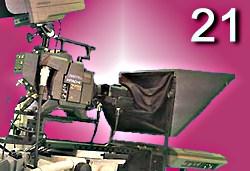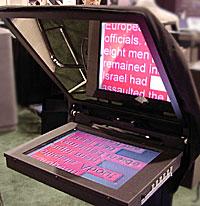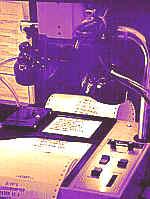|
Module 21 |
Updated: 07/05/2005 |
|
Camera
Most prompters (often referred to as TelePrompTers or Teleprompters
after the original manufacturer) rely on a reflected image of a script that's
visible in a half-silvered or two-way mirror in front of the camera lens. The side view of a camera prompter illustrates how this works. The image from the video monitor (displaying the text to be read) is reflected into a half-silvered mirror mounted at a 45-degree angle to the lens. The image of the text as seen by the prompter camera is electronically reversed left-to-right so that the mirror image will appear correct. |
|
Second, being semitransparent, the mirror allows much of the light from the scene being photographed to pass through its surface and go into the camera lens. When the talent looks at the prompter mirror to read the text, it appears as if they are looking right at the camera lens, and, therefore, at the audience. In order not to give the appearance
of constantly staring into the camera lens, most on-camera Some on-camera people prefer large posterboard cue cards with the script written out with a bold black marker. This approach has definite limitations. Not only does the use of cue cards require the aid of an extra person (a card puller), but the talent must constantly look slightly off to the side of the camera to see the cards. Plus, since the cards can't be reused, the approach ends up being rather expensive. Many news reporters working in the
field simply rely on handheld note cards or a small notebook containing names, figures
and basic facts. Some field reporters have mastered the technique of fully writing out the script, recording it on an audio cassette machine, and then playing it back in a small earphone while simultaneously repeating their own words on camera. Although this technique demands practice, concentration, and reliable audio playback procedures, once mastered, it can result in highly effective on-camera delivery. Even so, a camera prompter (Teleprompter) is the most relied
upon form of prompting, especially for long on-camera segments. There are two types
of camera prompters: hard copy and soft copy. Hard Copy Prompters The first type of on-camera prompter to be used, what became known as a hard copy prompter, uses long rolls of paper (see photo below) or clear plastic. When paper is used, the on-camera script is first typed in large
letters in short (typically, two to four-word) lines. The paper is attached to two
motor driven rollers and the image The script has to be scrolled at a carefully controlled speed while the talent reads the text. By means of a handheld control either a prompter operator or the talent, themselves, regulate the speed of the prompter. Hard copy prompters have now largely been replaced by -
Soft Copy Prompters Soft copy prompters display the output of a computer, much the same as the computer-monitor displays the text you are reading right now. This approach has several advantages. First, because the text is a direct, electronically generated image, it is sharp and easy to read. Revisions are easy to make without the legibility problems associated with crossing out words or phrases on paper and pencilling in last-minute corrections. Once the script is entered into the computer it can be electronically reformatted and displayed in a standard prompter format-narrow lines with large bold letters as shown below. If a color video prompter monitor is used, the text can be color-keyed
to set off the words of different speakers, or special instructions to the talent
that are not meant to be read aloud.
Sometimes you will see the text reversed for different speakers, as shown below.
When using cue cards or any type of on-camera prompting device there is always the issue of the compromise involved in the camera-to-subject distance. If the camera is placed close to the talent (making it easy for them to read the prompter), the constant left-to-right reading movement of their eyes can be distracting to an audience. Moving the camera back and zooming in reduces this problem by narrowing the left-to-right motion of the eyes; but, at the same time, the extra distance makes the prompter harder to read. The solution is to work with the talent to arrive at an acceptable compromise, and then hold to the agreed upon camera distances throughout productions. |


 mirror. First, it reflects the image from the video monitor screen, allowing
the talent to read the text. Note the photo on the right.
mirror. First, it reflects the image from the video monitor screen, allowing
the talent to read the text. Note the photo on the right. people
using prompters periodically glance at their scripts, especially as a way of emphasizing
facts and figures. (Having a paper script is always a good idea in case something
goes wrong with the prompter.)
people
using prompters periodically glance at their scripts, especially as a way of emphasizing
facts and figures. (Having a paper script is always a good idea in case something
goes wrong with the prompter.) They typically memorize their opening and closing on-camera comments and then speak
from notes, or even read a fully written script, while continuing with off-camera
narration.
They typically memorize their opening and closing on-camera comments and then speak
from notes, or even read a fully written script, while continuing with off-camera
narration. is
picked up by a video camera (see photo on left) and displayed on a video monitor,
as previously illustrated.
is
picked up by a video camera (see photo on left) and displayed on a video monitor,
as previously illustrated.